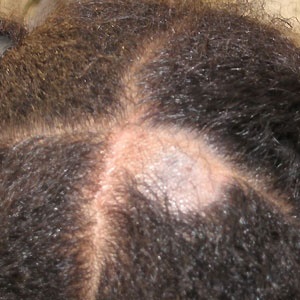
Ringworm of the scalp can cause hair loss in children.
It shows up as scruffy-looking dandruff or painful, draining spots on a child's scalp. Or the hair may start breaking off and falling out in clumps.
The solution: Get to the doctor's office. Head and Shoulders, or any kind of scalp treatment, isn't going to do a bit of good.
The condition is called ringworm of the scalp, but it's not a worm at all. Also known as tinea capitis, it's a contagious fungal infection that takes its name from the circular, worm-like pattern it produces on the skin.
The conditions is often also misdiagnosed as impetigo.
The infection spreads much the same way as head lice, through contact with another infected person or by sharing combs, hats, sleeping mats and other personal items.
Already accounting for more than 90 percent of fungal infections of the skin in children under age 10 in the United States, ringworm of the scalp is on the rise, health officials say.
Read: Coping with child hair loss
It's often misdiagnosed as dandruff, a bacterial infection or alopecia areata, a rare condition that causes hair loss. Once thought to be the result of poor hygiene and grooming, doctors know now that cleanliness - or lack of it - has nothing to do with those who get infected. But that's about all they know.
"We're definitely diagnosing more of it, but we don't really know why," says Dr. Amy McMichael, an associate professor of dermatology at Wake Forest University School of Medicine in North Carolina. "It may be the increased sports where children share helmets and any kind of equipment attached to the scalp."
With African-Americans making up more than 80 percent of patients treated for ringworm of the scalp, speculation has been that the condition is exacerbated by the use of hair treatments or tight braids.
But McMichael discounts that theory.
"I've seen lots of little boys who have it who don't put anything on their hair," she says. "We really don't know what causes it."
Parents should suspect ringworm of the scalp if their child has a sudden onset of dandruff, itching, hair loss or any combination of those, or scaling that doesn't respond to over-the-counter shampoos.
"It can appear as hair that looks like it's been chopped off at the scalp," McMichael says. "Look for unusual patchy areas of hair loss."
Diagnosis can be made in one of two painless ways
In the first, the doctor scrapes a small amount of scale from the infected area, treats it with potassium hydroxide, and views it under a microscope. She can also rub a moistened cotton tip over the area, apply it to a gel and grow the spore in a culture.
But that takes about three weeks, so if suspicions are high that it's ringworm of the scalp, it's best to go ahead and start treatment.
Fortunately, the condition is easy to clear up. The most effective treatment is a prescription antifungal medication called griseofulvin. It's taken orally because the spores infect the hair shaft and damage it internally.
"That's why you can't treat it with topicals," McMichael says. "They don't have a way to get into the hair follicles."
Once a child starts taking the medication, it's OK for him to go to school, says Judith Harrigan, training coordinator for the National Association of School Nurses in the US. But it's important to finish the course of treatment.
Read: Why children lose their hair
"It takes a while for it to really do its job," Harrigan says. "Parents will think it's better and think they can stop. They need to really listen to their health-care provider. It could be six to eight weeks of treatment."
It's also important to have everyone in the family tested for the condition, McMichael says. "If one person has it," she says, "all the children should be treated and everyone should get checked."
Adults, with their developed immune systems, are far less likely to become infected. But, McMichael says, she's often diagnosed the condition in a child just by looking at his parents' arms.
"I'll see a scaly patch on their arm and say, 'Do you have children? Have you been hugging them lately?' "
Fungal infections are common in South Africa where the hotter climate and higher fungal spore count in the air means that it can affect anyone. It is not a matter of personal hygiene.
Read more:
Niz shampoo for ringworm of the scalp
Sources: Interviews with Amy McMichael, M.D., associate professor of dermatology, Wake Forest University School of Medicine, Winston-Salem, N.C.; Judith Harrigan, RN, MSN, training coordinator, National Association of School Nurses




 Publications
Publications
 Partners
Partners











